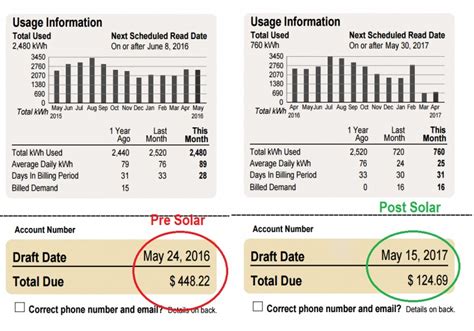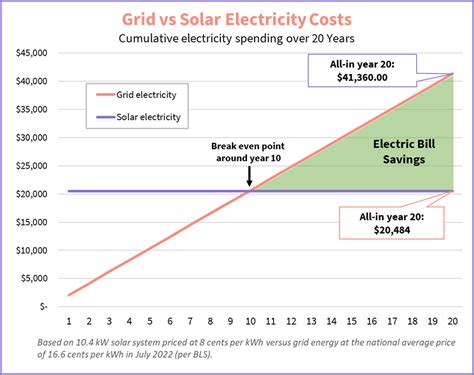
Switching to solar panels can dramatically reduce energy bills, but the true extent of the savings may only become apparent after several years, as one homeowner’s experience vividly demonstrates.
A homeowner’s viral TikTok video is highlighting the long-term financial benefits of solar panel installation, revealing a significant difference in energy bills five years after making the switch. The homeowner, identified as @frugalfitdad on TikTok, showcased a past energy bill of nearly $400 compared to a recent bill of just $28, illustrating the potential for substantial cost savings over time. The video has garnered significant attention, sparking a conversation about the viability and financial advantages of investing in solar energy for residential properties.
According to the TikTok user, the decision to invest in solar panels was driven primarily by financial considerations. “I got solar so I wouldn’t have an electric bill,” he stated in the video. This motivation resonates with many homeowners who are seeking to reduce their monthly expenses and gain greater control over their energy costs. The homeowner’s experience provides a compelling real-world example of the potential for solar energy to deliver on this promise.
The initial high cost of solar panel installation often deters homeowners, but the long-term savings can offset this initial investment. The homeowner’s experience underscores the importance of considering the long-term financial implications of solar energy, rather than focusing solely on the upfront costs. “It’s been five years, and I haven’t had an electric bill over $30, and that’s just the connection fee,” the homeowner explained.
The substantial reduction in energy bills demonstrated in the video reflects broader trends in the solar energy market. As solar technology advances and becomes more affordable, more homeowners are considering it as a viable alternative to traditional energy sources. The economic and environmental benefits of solar energy are becoming increasingly compelling, driving wider adoption of this renewable energy source.
The video also touched on the environmental benefits, alluding that moving to solar panel significantly lowered carbon footprints, and urging other homeowners to consider it as an important option.
The Rising Cost of Energy and the Appeal of Solar
One of the key factors driving the growing interest in solar energy is the rising cost of traditional energy sources. Utility companies across the country have been increasing their rates in response to various factors, including infrastructure upgrades, fuel costs, and regulatory changes. As a result, homeowners are facing higher monthly energy bills, which are straining household budgets.
In this context, solar energy offers a compelling alternative. By generating their own electricity, homeowners can reduce their reliance on the grid and shield themselves from fluctuating energy prices. This energy independence is a significant advantage, providing homeowners with greater financial stability and predictability.
Moreover, solar energy offers environmental benefits that appeal to environmentally conscious homeowners. By reducing their reliance on fossil fuels, homeowners can lower their carbon footprint and contribute to a cleaner, more sustainable energy future. The combination of economic and environmental benefits makes solar energy an increasingly attractive option for homeowners looking to reduce their energy costs and minimize their environmental impact.
Analyzing the Savings: A Deeper Dive
The homeowner’s experience highlights the potential for significant long-term savings with solar energy. However, it is important to understand the factors that can influence the actual savings realized by homeowners. These factors include:
-
Energy Consumption: Homes with high energy consumption tend to see larger savings from solar panel installation. The more electricity a home uses, the greater the potential to offset those costs with solar energy.
-
Solar Panel System Size: The size of the solar panel system should be tailored to the home’s energy needs. A larger system can generate more electricity, but it also comes with a higher upfront cost. It is important to carefully assess energy consumption patterns to determine the optimal system size.
-
Sunlight Exposure: The amount of sunlight a home receives can significantly impact the performance of solar panels. Homes in areas with abundant sunshine will generate more electricity than those in cloudier regions. Factors such as shading from trees or nearby buildings can also affect sunlight exposure.
-
Net Metering Policies: Net metering policies allow homeowners to sell excess electricity generated by their solar panels back to the grid. This can further reduce energy bills and potentially generate income for homeowners. However, net metering policies vary by state and utility company, so it is important to understand the specific regulations in your area.
-
Incentives and Rebates: Government incentives and rebates can help to offset the upfront cost of solar panel installation. These incentives can include federal tax credits, state rebates, and local utility programs. Taking advantage of these incentives can significantly reduce the overall cost of investing in solar energy. The federal tax credit allows homeowners to deduct 30% of the cost of installing solar panels from their federal taxes.
-
Financing Options: Various financing options are available for solar panel installation, including loans, leases, and power purchase agreements (PPAs). Each option has its own advantages and disadvantages, so it is important to carefully consider the terms and conditions before making a decision. Loans allow homeowners to own the solar panel system, while leases and PPAs involve paying for the electricity generated by the system.
The Broader Context: Growth of the Solar Industry
The homeowner’s experience is not an isolated case. The solar industry has been experiencing rapid growth in recent years, driven by technological advancements, declining costs, and increasing awareness of the benefits of renewable energy. According to the Solar Energy Industries Association (SEIA), solar energy accounted for 4% of total U.S. electricity generation in 2022.
The growth of the solar industry has been supported by government policies and incentives, such as the federal tax credit for solar panel installation. These policies have helped to make solar energy more affordable and accessible to homeowners and businesses alike. As solar technology continues to improve and costs continue to decline, the solar industry is poised for continued growth in the years to come.
The Inflation Reduction Act of 2022 extended and expanded the federal tax credit for solar panel installation, providing further incentives for homeowners and businesses to invest in solar energy. The act also included provisions to support domestic manufacturing of solar panels and other renewable energy technologies, which could further reduce costs and create jobs in the U.S.
Challenges and Considerations
Despite the many benefits of solar energy, there are also some challenges and considerations to keep in mind. These include:
-
Upfront Costs: The initial cost of solar panel installation can be a barrier for some homeowners. While costs have declined significantly in recent years, solar panel systems still represent a significant investment. However, financing options and government incentives can help to make solar energy more affordable.
-
Aesthetics: Some homeowners are concerned about the aesthetics of solar panels on their roofs. However, solar panel technology has improved significantly in recent years, and there are now more aesthetically pleasing options available, such as solar shingles and integrated solar panels.
-
Maintenance: Solar panels require some maintenance to ensure optimal performance. This includes cleaning the panels regularly to remove dirt and debris, as well as inspecting the system for any damage or malfunctions. However, solar panels are generally low-maintenance, and most systems come with warranties that cover repairs and replacements.
-
Home Resale Value: The impact of solar panels on home resale value is a complex issue. Some studies have shown that homes with solar panels sell for more than comparable homes without solar panels, while others have found no significant impact. Factors such as the age and condition of the solar panel system, the remaining warranty coverage, and the local real estate market can all influence the impact on home resale value.
-
Weather Dependence: Solar energy is weather-dependent, meaning that the amount of electricity generated can vary depending on the amount of sunlight available. This can be a concern for homeowners in areas with frequent cloud cover or limited sunlight. However, solar panel systems can be designed to account for weather variations, and backup power sources, such as batteries or generators, can be used to ensure a reliable supply of electricity.
The Role of Energy Storage
Energy storage, particularly in the form of batteries, is playing an increasingly important role in the solar energy market. Batteries allow homeowners to store excess electricity generated by their solar panels and use it later, when the sun is not shining. This can further reduce reliance on the grid and provide backup power during outages.
Battery technology has improved significantly in recent years, and costs have declined, making energy storage more affordable and accessible. Many homeowners are now choosing to install batteries along with their solar panels to maximize the benefits of solar energy.
The combination of solar panels and batteries can provide homeowners with greater energy independence and resilience. In the event of a power outage, batteries can provide backup power for essential appliances and devices, ensuring that homeowners can stay comfortable and connected.
Expert Opinions and Industry Insights
Industry experts agree that solar energy is poised for continued growth in the years to come. Factors such as declining costs, increasing awareness of the benefits of renewable energy, and government policies and incentives are all driving demand for solar energy.
“Solar energy is becoming increasingly affordable and accessible, making it a viable option for more and more homeowners,” said Abigail Ross Hopper, president and CEO of the Solar Energy Industries Association (SEIA). “The combination of economic and environmental benefits is driving wider adoption of solar energy.”
“Energy storage is also playing an increasingly important role in the solar energy market,” said Kelly Speakes-Backman, CEO of the Energy Storage Association (ESA). “Batteries allow homeowners to store excess electricity and use it later, providing greater energy independence and resilience.”
Rewriting with Focus on Homeowner Perspective
The core of the solar revolution is its impact on homeowners. Rewriting with this in mind provides a more compelling narrative.
The financial relief offered by solar panels is more than a theory; it’s a tangible reality for homeowners like @frugalfitdad. His story isn’t just about saving money; it’s about gaining control. The initial investment, though significant, is an investment in future energy independence.
Imagine no longer dreading the arrival of the monthly electric bill. Instead, you see a modest charge, a mere fraction of what you once paid. This is the promise of solar, a promise of predictable energy costs.
Beyond the financial gains, homeowners are attracted to the environmental benefits. The feeling of contributing to a cleaner planet, reducing your carbon footprint, is a powerful motivator.
It’s about transforming your home into a mini power plant, harnessing the sun’s energy to power your life. It’s a move towards sustainability, self-sufficiency, and ultimately, peace of mind.
Extending on the Topic: Community Solar
For homeowners who may not be able to install solar panels directly on their homes (e.g., renters, those with heavily shaded roofs, or those living in apartment buildings), community solar offers an alternative. Community solar projects are shared solar facilities that allow multiple customers to subscribe to a portion of the electricity generated. Subscribers receive credits on their electricity bills for their share of the solar energy produced, effectively reducing their energy costs.
Community solar expands access to solar energy to a wider range of consumers, including those who may not otherwise be able to participate. It also provides benefits to the community as a whole, such as increased renewable energy generation and reduced reliance on fossil fuels.
Solar Panel Lifespan and End-of-Life Considerations
Solar panels are a long-term investment, with a typical lifespan of 25-30 years. However, it is important to consider what happens to solar panels at the end of their useful life.
While solar panels are generally recyclable, the recycling process can be complex and costly. Currently, there is limited infrastructure in place to recycle solar panels on a large scale. As the number of solar panels installed continues to grow, it is important to develop more efficient and cost-effective recycling methods.
Some companies are now offering solar panel recycling services, which can help to ensure that solar panels are disposed of responsibly. These services typically involve dismantling the panels, separating the materials, and recovering valuable components, such as silicon and aluminum.
Addressing Misconceptions About Solar Energy
Despite the growing popularity of solar energy, some misconceptions persist. It is important to address these misconceptions to ensure that homeowners have accurate information when considering solar energy.
-
Misconception: Solar panels don’t work on cloudy days.
- Fact: Solar panels can still generate electricity on cloudy days, although the amount of electricity produced will be less than on sunny days. Solar panels are designed to capture diffuse sunlight, which is present even on cloudy days.
-
Misconception: Solar panels are too expensive.
- Fact: The cost of solar panels has declined significantly in recent years, making them more affordable than ever before. Government incentives and financing options can also help to reduce the upfront cost of solar panel installation.
-
Misconception: Solar panels require a lot of maintenance.
- Fact: Solar panels are generally low-maintenance. They may need to be cleaned periodically to remove dirt and debris, but otherwise, they require little attention.
-
Misconception: Solar panels will damage my roof.
- Fact: Solar panels are designed to be installed on roofs without causing damage. Reputable solar installers will ensure that the panels are properly installed and that the roof is protected.
-
Misconception: Solar panels are only for people who live in sunny climates.
- Fact: Solar panels can work in any climate, although they will generate more electricity in sunny climates. Even in areas with limited sunlight, solar panels can still provide significant savings on energy bills.
The Future of Solar Energy
The future of solar energy is bright. As technology continues to improve and costs continue to decline, solar energy is poised to become an even more important part of the global energy mix. Innovations such as perovskite solar cells, which are more efficient and less expensive to produce than traditional silicon solar cells, could further accelerate the growth of the solar industry.
The increasing adoption of electric vehicles (EVs) is also driving demand for solar energy. Homeowners who own EVs can use solar panels to charge their vehicles, further reducing their energy costs and minimizing their environmental impact.
FAQ Section:
Q1: How much does it typically cost to install solar panels on a home?
A: The cost of solar panel installation varies depending on several factors, including the size of the system, the type of panels used, and the location of the home. As a rough estimate, a typical residential solar panel system (around 5kW) can cost anywhere from $15,000 to $25,000 before incentives. However, government incentives, such as the federal tax credit, can significantly reduce the overall cost. The federal tax credit allows homeowners to deduct 30% of the cost of installing solar panels from their federal taxes.
Q2: How long does it take for solar panels to pay for themselves?
A: The payback period for solar panels depends on several factors, including the cost of the system, the amount of electricity generated, and the local electricity rates. On average, solar panels can pay for themselves in 7 to 12 years. However, this can vary depending on individual circumstances. Factors such as net metering policies and government incentives can also affect the payback period.
Q3: What are the benefits of net metering?
A: Net metering allows homeowners to sell excess electricity generated by their solar panels back to the grid. This can further reduce energy bills and potentially generate income for homeowners. When a homeowner’s solar panels generate more electricity than they need, the excess electricity is sent back to the grid, and the homeowner receives a credit on their electricity bill. This credit can then be used to offset the cost of electricity consumed from the grid at other times.
Q4: How long do solar panels last?
A: Solar panels typically have a lifespan of 25-30 years. However, they may continue to generate electricity beyond this period, although at a reduced rate. Most solar panel manufacturers offer warranties that guarantee a certain level of performance for a specified period, typically 25 years.
Q5: What happens to solar panels at the end of their useful life?
A: Solar panels are generally recyclable, but the recycling process can be complex and costly. Currently, there is limited infrastructure in place to recycle solar panels on a large scale. As the number of solar panels installed continues to grow, it is important to develop more efficient and cost-effective recycling methods. Some companies are now offering solar panel recycling services, which can help to ensure that solar panels are disposed of responsibly. These services typically involve dismantling the panels, separating the materials, and recovering valuable components, such as silicon and aluminum.
Conclusion:
The experience of @frugalfitdad, the homeowner highlighted in the TikTok video, serves as a compelling case study of the long-term financial benefits of solar panel installation. While the initial investment can be significant, the potential for substantial savings on energy bills over time is undeniable. As energy costs continue to rise and solar technology becomes more affordable, solar energy is poised to become an increasingly attractive option for homeowners looking to reduce their expenses, gain energy independence, and minimize their environmental impact. The growth of the solar industry, supported by government policies and incentives, underscores the increasing importance of renewable energy in the global energy mix. While challenges and considerations remain, the benefits of solar energy are clear, making it a viable and increasingly popular choice for homeowners around the world. The key to maximizing the benefits of solar energy is to carefully assess individual energy needs, understand the local regulatory environment, and take advantage of available incentives and financing options. With the right planning and execution, solar energy can provide homeowners with a sustainable and cost-effective way to power their homes for years to come. The homeowner’s story, amplified by social media, highlights a critical trend: solar energy is no longer a niche technology but a mainstream solution for homeowners seeking financial savings and environmental responsibility.









